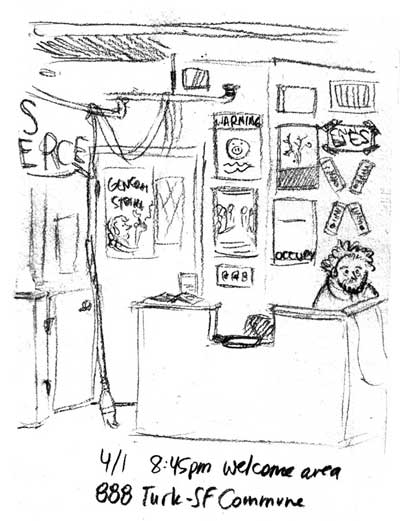 It lasted less than 24 hours, but the Occupy SF Commune at 888 Turk may have pushed the movement forward harder than many other of the movement’s Bay Area actions of late. And despite Monday’s raid, many occupiers saw the building operation as a success.
It lasted less than 24 hours, but the Occupy SF Commune at 888 Turk may have pushed the movement forward harder than many other of the movement’s Bay Area actions of late. And despite Monday’s raid, many occupiers saw the building operation as a success.
The 888 Turk building is not only the story of this brief building occupation, but also its place in the context of Bay Area activism, Occupy and beyond, on the eve of the planned May 1 General Strike. On January 28, many of these same people attempted a building occupation in Oakland, which turned into the tear gas, less-lethal melee that spawned another Occupy backlash there.
The 888 Turk occupation was, in Occupy terms, an escalation so profound and unexpected that many dismissed it as an April Fool’s joke – even at the expense of Occupy Oakland and its brutal J28 crushing, which resulted in more than 400 arrests.
But the SF Commune was not a joke; the Spring Awakening took the city by storm, if only for a day. Within a half hour of the building’s occupation, several large place-making banners were dropped from the roof, including many with Christian slogans and quotes, including, “Forgive us our trespasses” in white letters on black cloth.
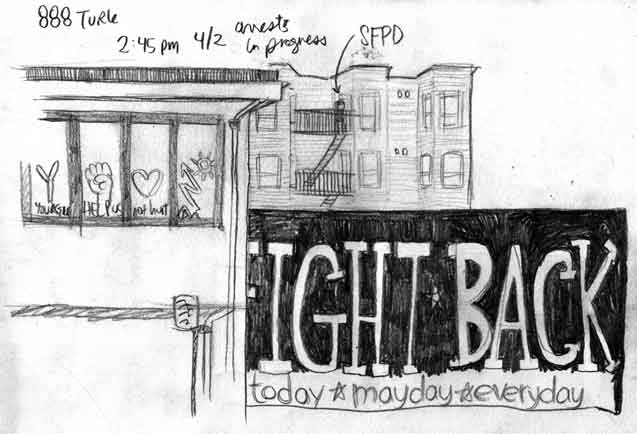
It was clear how much the building meant to the movement that has largely been overshadowed by its wild East Bay neighbors. At least 22 school chairs were used to reinforce a barricade holding police out of the lot behind 888 Turk. Nearby, scrawled on a door: “When the cities burn down, we’ll all be warm.”
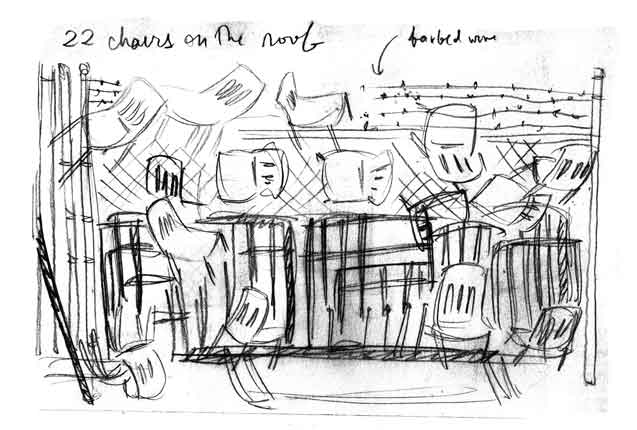
The activist group Homes Not Jails, that was involved in the 888 Turk action, has been occupying buildings in San Francisco for about 20 years. They opened several hundred buildings from the mid to late ’90s, creating symbolic short-lived occupations in some spaces and holding off police for days on end in others. While many occupiers were excited by 888 Turk, some seasoned activists were nonplussed.
“This is an old tactic,” said Lydia Blumberg, who has worked with Homes Not Jails in the past and had brought her four-year-old daughter to the building’s “Sacred Space” the prior evening. “We’ve been doing this for years.”
A year ago next week, Homes Not Jails occupied a San Francisco apartment building owned by Kaiser Permanente. A banner hung from the roof read “Hella Occupy” – more than six months before Occupy Wall Street was born and that phrase came to typify the Bay Area iteration of the movement.
Homes Not Jails, first took the 600-unit Cathedral Hill Hotel on October 10. Occupiers took the building once again on January 20 following the “Occupy Wall Street West” day of action, which shut down the downtown San Francisco financial district.
“It makes me optimistic that we have all these kids carrying the torch,” said Blumberg.
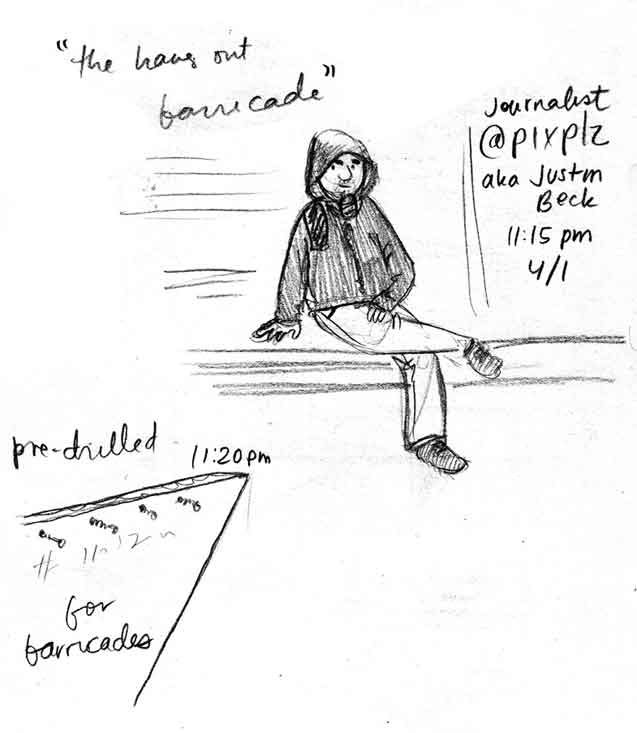
It may not be a bank, but occupiers were quick to point out how the Catholic Church is the 1 percent, especially in the Bay Area, where they own many vacant properties on which they do not pay property taxes.
The 9,950 square foot, two-story building at 888 Turk became Occupy SF’s Commune used to house Westside Community Crisis and Outpatient mental health services. The 888 Turk building had received numerous complaints for failure to register in the city’s vacant building registry. It is set to respond to those complaints on April 19 in a hearing. According to online real estate listings, it is currently listed for lease at $11,000 monthly.
“I was completely blown away. Cathedral Hill was cool and all, but this was just beautiful,” said occupier Jesse Smith of 888 Turk. “We learned from Cathedral Hill,” said Smith, “barricades, contingency plans.”
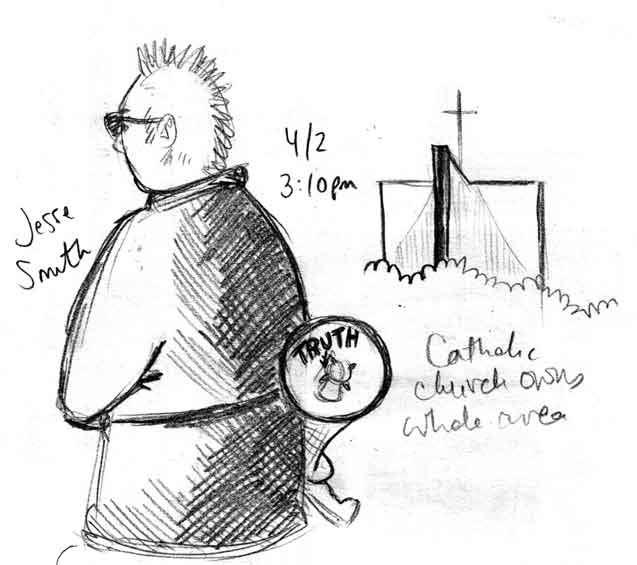
“The camps made a statement and were great to be visible but for the longterm mission of occupy, we need buildings,” said Jesse Smith. The clear strategic advantage doesn’t hurt, either. “It’s a hell of a lot harder to kick us out of a building than it is to kick us out of a park.”
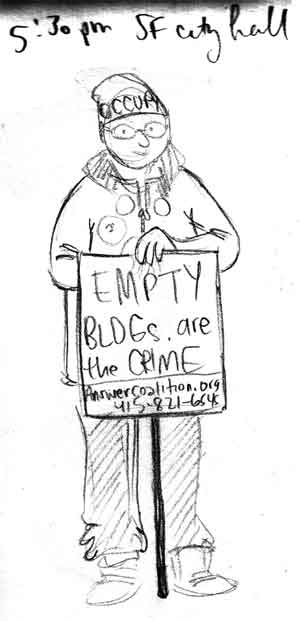 Occupiers first took the building around 5:45 PM on Sunday, April 1, following a march of several hundred from downtown. It was clear that activists had held the building for some time before opening it – assignment of rooms and a skeletal organizational structure were already in place, as were signage and literature. The police said they were “monitoring” the situation, but couldn’t do anything unless the Catholic Archdiocese of San Francisco filed a formal complaint of citizen’s arrest, asking for the occupiers’ removal – and they hadn’t.
Occupiers first took the building around 5:45 PM on Sunday, April 1, following a march of several hundred from downtown. It was clear that activists had held the building for some time before opening it – assignment of rooms and a skeletal organizational structure were already in place, as were signage and literature. The police said they were “monitoring” the situation, but couldn’t do anything unless the Catholic Archdiocese of San Francisco filed a formal complaint of citizen’s arrest, asking for the occupiers’ removal – and they hadn’t.
The most tense moment that first night came when the police briefly held up the occupiers’ pizza delivery.
By the next morning, things had changed. The San Francisco police had declared the area a “crime scene” and were for the most part limiting access to the building for both people and supplies. One particularly tough battle involved the delivery of morning coffee; occupiers were ultimately successful.
San Francisco occupier Alex Kerfoot told me “it was like siege warfare.” And that was before police moved in.
Shortly before 2 PM, San Francisco police and county sheriffs began the raid on 888 Turk, following over a dozen hours of monitoring the situation and noting that because people were bringing in supplies, “those trespassing inside intended to remain inside and were not going to leave.” At some point on Monday, police say, an Archdiocese representative also requested the San Francisco Police Department (SFPD) remove the protesters, and signed a citizens arrest for trespassing giving the agency the authority to do so. According to Kerfoot, occupiers inside the building were on the phone, planning to meet with the Archdiocese at 3 PM about the future of the building.
Occupiers said the building had been vacant for five years, but a spokesperson for the Archdiocese said it had only been vacant for 18 months, and was previously housing Sacred Heart Cathedral Preparatory High classes. The Archdiocese declined to meet with a delegation of occupiers who marched to the cathedral uphill from 888 Turk late Monday afternoon following the raid.
Police moved in suddenly and without warning. Journalist Steve Rhodes, having heard police were on their way, attempted to leave, but was unable.
“Some people were trying to close the door and some people were trying to open the door to get out. And then the riot police arrived,” he told me. “I was right at the entrance and I saw these riot police coming out – and my first thought was, take some photos.” Rhodes didn’t have a chance, though, because “there were non-lethal [shotguns] directed at my face when I was ordered to put my hands on my head.” He was cited with misdemeanor trespassing and released around 7 PM on Monday.
“They will often warn people so they don’t have to arrest as many,” Rhodes said of the SFPD’s approach to building occupations in the city. “But in this case it seemed they wanted to contain and intimidate.”
Occupiers were arrested room by room. According to police, “trespassers retreated into rooms, many of which were barricaded from the inside, while others closed doors to an interior stair well and retreated to the second floor.” One person jumped off the roof and was arrested.
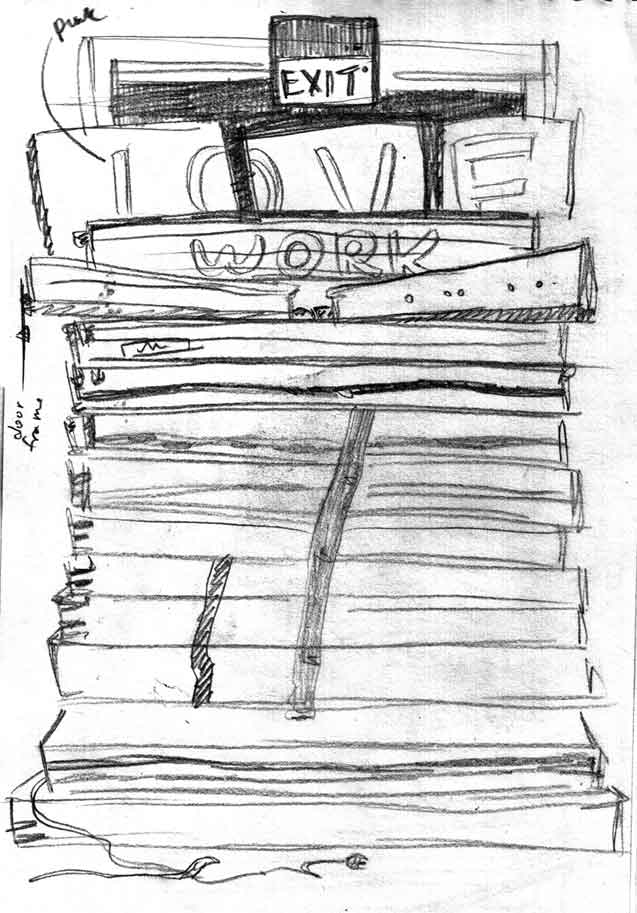
Police feared a fight that never came. Protesters defended the commune vigorously with barricades, but nothing was thrown at police before, during or after the raid of 888 Turk Street, but the SFPD forwarded photos of piles of bricks to the press following the raid. “There was concern that these items were going to be used as weapons against police officers,” the SFPD said in a statement. The building was also marked by graffiti inside and out, ranging from hearts and messages of peace, including “Gun Free Zone” on the front facade, to “Kill Cops” and endless bacon jokes in upstairs corridors.
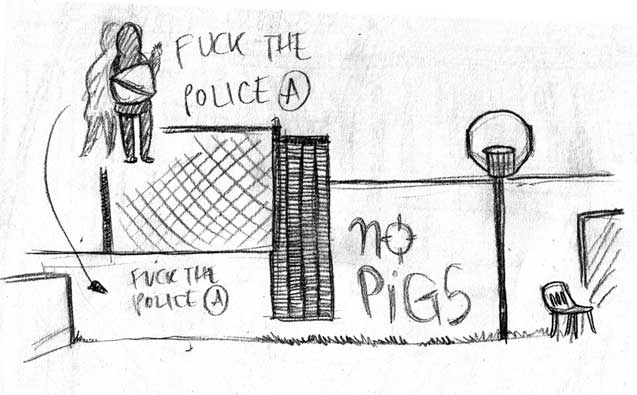
In all, 75 people were arrested and cited for misdemeanor trespassing, and three dogs were detained by city animal control.
The raid, though relatively peaceful, was not without shows of brutality. One protester, Nick Shaw, was put into a control hold by officers several times during the course of his arrest for alleged non-cooperation when asking for medical assistance to treat his injured hand. At one point, Shaw lost consciousness on the bus headed for the jail and arrestees attempted to gain the attention of media and onlookers to obtain care. SFPD would not allow on-scene EMTs to care for Shaw, choosing instead to cite and release him earlier than other protesters.
Many of the arrestees were not in a sense residents of Occupy San Francisco; many were from Oakland, UC Berkeley, and other Bay Area protest sites. This sort of regional cross-pollination and convergence has been happening more and more across the Northern California iterations of the movement. While this can at times cause problems with splitting the crowd, this fluidity across the region also stands to unite the area headed into the May 1 General Strike, the painfully ironic court date many of the 888 Turk arrestees received for their trespass.
“Because it’s Occupy and not Homes Not Jails they think that this would keep people from joining another occupation,” said Rhodes of the 888 Turk crackdown. “Whereas all it may do is inspire more people to get involved.”
“It makes me optimistic that this going to be a more widespread movement,” said Blumberg. “It makes me optimistic because this used to be a totally radical fringe thing, and now you’ve got the whole Occupy movement surrounding it and taking it up as their cause.”
“People who otherwise wouldn’t have participated in Mayday are able to look at this sort of stuff, see what it is we’re able to do and that we’re not trying to hurt anybody,” said Smith of the SF Commune action. “SFPD’s biggest mistake was letting us do this,” said Jesse Smith. “It just proves to us and every other occupy in the country that this can be done.”
48 Hours Left: All gifts to Truthout now matched!
From now until the end of the year, all donations to Truthout will be matched dollar for dollar up to $31,000! Thanks to a generous supporter, your one-time gift today will be matched immediately. As well, your monthly donation will be matched for the whole first year, doubling your impact.
We have just 48 hours left to raise $31,000 and receive the full match.
This matching gift comes at a critical time. As Trump attempts to silence dissenting voices and oppositional nonprofits, reader support is our best defense against the right-wing agenda.
Help Truthout confront Trump’s fascism in 2026, and have your donation matched now!